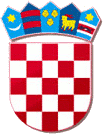Croatian coat of arms
|
|
The Croatian coat of arms consists of one main shield and five smaller shields which form a crown over the main shield. The main coat of arms is a checkerboard (chequy) that consists of 13 red and 12 silver (white) fields. It's commonly known as šahovnica ("chessboard", from ah, "chess" in Croatian). The smaller shields represent parts of Croatia.
| Contents |
History

Coashs.jpg
The red and white checkerboard has been a symbol of Croatian kings since at least the 10th century, ranging in size from 3×3 to 8×8, but most commonly 5×5, like the current coat. It was traditionally conjenctured that the colours originally represented two ancient Croat tribes, Red Croats and White Croats, but there is no generally accepted proof for this theory. The oldest source confirming the coat as an official symbol is a genealogy of the Habsburgs, dated from 1512 to 1518. In 1525 it was used on a votive medal.
Traditionally, it was used as the coat of arms of Croatia proper, i.e. the historical province of Croatia, excluding Dalmatia and Slavonia, which had their own coats of arms. The three shields of Croatia proper, Slavonia and Dalmatia were often used together to represent the whole of Croatia in Austria-Hungary. By late 19th century ahovnica had come to be considered a generally recognized symbol for Croats and Croatia and in in 1919, it was included in the coat of arms of the Kingdom of Serbs, Croats and Slovenes (later the Kingdom of Yugoslavia) to represent Croats.
After the Second World War, the new Socialist Republic of Croatia became a part of the federal Second Yugoslavia. The ahovnica was included in the new socialist coat of arms which was designed in the socialist tradition, including symbols like wheat for peasants and an anvil for workers, as well as a rising sun to symbolize a new morning and a red star for communism. The ahovnica by itself was indirectly associated with the fascist Ustashe regime which had ruled Croatia during the Second World War and its use as a stand-alone symbol was considered nationalistic and discouraged.
The current design
On 21 December 1990, the post-communist government of Croatia, passed a law prescribing the design created by the graphic designer Miroslav Šutej, under the aegis of a commission chaired by Nikša Stančić, then head of the Department of Croatian History at the Faculty of Philosophy, University of Zagreb.
The new design added the five crowning shields which represent the historical regions from which Croatia originated. They are, from left to right:
- the oldest known Croatian coat of arms: a golden six-pointed star (representing the morning star) over a silver moon on a blue shield. It represents the capital city Zagreb and central Croatia in general.
- an older coat of arms of the Republic of Dubrovnik: two red stripes on a dark blue shield, given to Dubrovnik by the Árpád dynasty, who were Croato-Hungarian kings in the 15th century.
- the coat of arms of Dalmatia: three golden, crowned leopards, two over one, on a blue shield. This coat was Dalmatian since the 13th century and probably originates from the Anjou ruling dynasty.
- the coat of arms of Istria: a golden goat with red hooves and horns, on a dark blue shield.
- the coat of arms of Slavonia: two silver stripes on blue shield (representing the rivers Drava and Sava that mark the northern and the southern border of Slavonia), between them on a red field a black, running marten (kuna), above a six-pointed, golden star. This coat was assigned to Slavonia by king Ladislaus Jagiello in 1496.
Some of the more traditional heraldic pundits have criticized the latest design for various unorthodox solutions, such as adding a crown to the coat, varying shades of blue in its even fields, and adding the red border around the coat. The government has accepted their criticism insofar as not accepting further non-traditional designs for the county coats of arms, but the national symbol has remained intact.
Unlike in many countries, Croatian design more commonly uses symbolism from the the coat-of-arms, rather than from the Croatian flag. This is partly due to the geometric design of the shield which makes it appropriate for use in many graphic contexts (e.g. the insignia of Croatia Airlines), and partly due to the fact that neighbouring countries like Slovenia and Serbia and Montenegro use the same Pan-Slavic colours on their flags as Croatia.
Trivia
- The pattern of ahovnica resembles an autochthone flower called kockavica, which is sometimes associated with the coat of arms.
- Some right-wing Croats claimed that the colour of the top left square is a mark of whether Croatia is independent or ruled by foreigners, white or red respectively. However, this is a red herring because only the short-lived Nazi puppet state "Independent State of Croatia" had the upper left square white with such an intent. Croatia is currently independent and the first square is red.
External link
- Željko Heimer's explanation of the coat of arms (http://public.srce.hr/~zheimer/hrgrb.htm)de:Wappen Kroatiens


